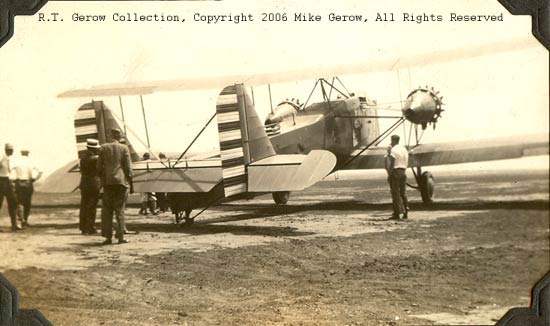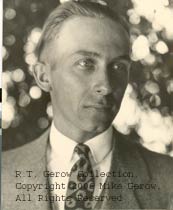|
Imagine the excitement in Bakersfield, CA on on
Friday, November 5, 1926.
Admiral Byrd's North Pole Fokker, NX4204 lands
during its 40-city U.S. tour that began October 7th. Follow
the airplane link for detailed information about the airplane,
its pilots and passengers, and its visit to the Davis-Monthan
Airfield three days and four stops after these images
were taken. Follow this link to pilot Floyd
Bennett for additional
images of the airplane and crew.
Below, straight from Gerow's album, are five shots
he took of the crowds and action surrounding the welcome
of the "Josephine Ford", pilot Bennett and crew
to Bakersfield, one of seven cities added to the original
itinerary as food/fuel stops along the way. Here, as always,
the airplane taxied in, parked among the
throng, and speeches were given (note the unknown official
in a suit speaking under the wing) to boost aviation in the
public eye and to increase awareness of the need for more
airports, airmail, passenger routes and other manifestations
of progress that aviation would usher in.
Interestingly, the lower left image above shows the Josephine
Ford just before touchdown (there is space between the wheels
and the ground, visible with a loupe).
Below, crowd
control was good this hazy day, with most people remaining
at a good distance.
A classic profile of a classic airplane. Sitting in the
cockpit and watching that naked Wright "Whirlwind" radial
thrumming at arms-length must have been like watching open-heart
surgery!
The "Josephine Ford",
NX4204, at Bakersfield, CA, November 5, 1926
 |
---o0o---
Below, two images of Keystone bomber 28-391.
The number is just visible on the original image, just under
the right bottom wing. This airplane landed at the Davis-Monthan
Airfield three times during 1929. Two landings were piloted
by Odas Moon, a founding member of the Order
of Daedalians.
Keystone Bomber 28-391
 |
Starboard aft view shows the sparse, but strong, engine
mount geometry.
Keystone Bomber 28-391
 |
---o0o---
These candid snapshots of air racers were taken
by Mr. Gerow at Los Angeles during the 1933 National Air
Races (July 1-4). Scroll below to see what the backs of these
snaps look like. Pilots Wittman,
Minor and Turner signed the Davis-Monthan Register. They
brought none of these airplanes to Tucson, however.
Some 1933 National Air Racers
 |
The backs of the snaps above reveal information noted
by Gerow about the airplanes and their pilots. The notation
about Wittman's "crude" construction of his airplane was
more than prophetic. See Wittman's web page for sad details.
Reverse Sides of 1933 National Air Racers Snapshots
 |
Roscoe Turner took first place in the Bendix Race in 1933
and earned $5,050 cash. He also finished first (24:53:46
over ten laps of a ten mile course) in the Thompson Trophy
run, but he was disqualified for cutting pylon number 3.
In total, the three Davis-Monthan pilots took 1st, 2nd or
3rd place in most of the race events. The aircraft
in the snaps above were the hot jobs that year.
---o0o---
Below, in the image of three beautiful Curtiss
Helldivers coming in over the Long Beach shoreline, you
will notice a long flat ship in the distance just above the
tail of the far right aircraft in the formation. This is
the Navy's first aircraft carrier, USS Langley (CV-1), which
was assigned to the Battle Fleet at San Pedro at that
time. Langley was later converted to a seaplane tender and
was scuttled as a result of battle damage received in early
1942. The Rainbow Pier is on the shoreline below the airplanes.
Curtiss Helldivers
Over Long Beach, CA, ca. 1931
 |
Two of the Helldivers above can be identified from the original
image using a magnifier. The planes are, left to right:
4, 2 & 5
of VN-13. The Register lists Long Beach as Home Base of
Helldivers 2 & 5,
which signed in on
6/11/32: Ship #2-- Lt (jg) Paul T. Adams.
For Ship # 5--Ensign Glen Jackson landed and signed in
sometime between 8/24/31 and 9/4/31 on the same Register page.
Fast forward almost 80 years to present. What would these pilots see from their Helldivers today from about the same position they were captured in the photograph above? Below is the answer to the question in a contemporary aerial photograph taken by Mike Gerow. Note the red arrow.
Long Beach, CA, March, 2008
 |
The red arrow points to the Villa Riviera. This same building, little changed today except that it is now luxury condos, not a hotel, can be seen as the taller of the two buildings in the lower left corner of the Helldivers photograph above. Click on the Villa Riviera link. The night shot on the home page looks off to Signal Hill on the horizon at upper left. Just on the other side would be Long Beach Airport. Go here to see Signal Hill juxtaposed to the old airport. At the time of the Register, it was covered with oil derricks.
Little else is recognizable in this contemporary photo, except on might divine an outline of the old Rainbow Pier in the geometry of the bow subtended on the right by the Villa Riviera. In 1931 the Villa Riviera was beachfront property. Today it is several hundred landfilled yards from the water. Long Beach Airport is at the upper left. The dock structures in the foreground are also landfill. Lt. Adams and Ensign Jackson would not believe their eyes.
---o0o---
Below, the U.S. Navy Ford Trimotor, A-7526. The number is
clearly readable on the original image. This airplane was
a prolific visitor to the Davis-Monthan Airfield, landing
there six times during 1928 and 1929. It was also a prolific
carrier of passengers, arriving and departing with 34 of
them, including the Asst. Secretary of the Navy (David S. Ingalls at the time), over the
six trips.
Ford Trimotor A-7526
 |
Another two views of A-7526 are at the Klein
Archive available on this site.
---o0o---
Below, Curtiss-Roberston NC7499, which landed three times
at Tucson on 9/9/1928, 8/24/1931 and in late August or early
September 1931 (the pilot didn't enter a date: estimated
by interpolation). This could be the same airplane pictured
with Mr. Gerow on this page.
Curtiss Robertson Robin 1, NC7499
 |
Enhanced Registration Number
 |
Unfortunately, the identities of the man and the children
are lost to history. The man might be Saiten, Shelton or
Hampton. Does anyone know who
they might be?
How, you ask, did we determine the registration
number of this airplane? We cropped the rudder and enhanced
the image with PhotoShop CS. We teased the numbers from the
rudder as seen in the small image at right.
The image above
is as the original. Except for the exercise at right to
pry the number off the rudder, all the images, in all the
Collections on this Web site, are unretouched except for cropping,
sizing and optimizing for web presentation.
---o0o---
The Ryan, below, landed at Tucson twice in
June and July 1929. It was flown by Reg Robbins of Robbins
and Kelly, who flew this airplane during May of 1929 at Ft.
Worth, Texas to break all endurance
records for sustained flight. They remained aloft for
172 hours, 31 minutes, but landed when a propeller
blade cracked and began vibrating. The lettering on the fuselage
between the wing struts commemorates that feat. See a better resolution image at NR1766.
NR1766, Ryan "Ft. Worth"
 |
---o0o---
Image, below, of one of the great Granville
Brothers (GeeBee) racing aircraft, NR2101.
Compare this image with the one at the link and you'll be
able to see the difference in fuselage length behind the
cockpit between this airplane and the so-called R1/R2 hybrid
(18" added). Read on this site about the airplane and its
manufacturer here.
NR2101 Gee Bee Racer
 |
---o0o---
THIS PAGE UPLOADED: 11/28/06 REVISED: 12/20/07, 03/25/08
|















